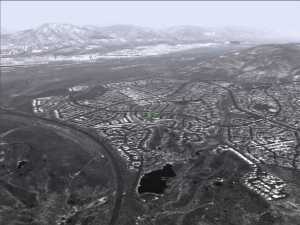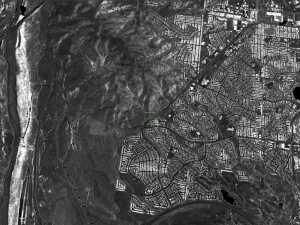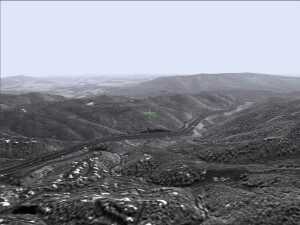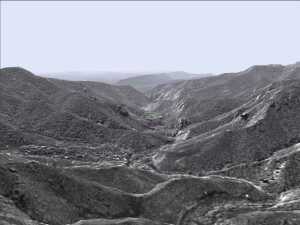vol 2 num 9

from VizMAP – letting you see where you stand…
Volume 2 – Number 8
|
| About VizMAP
VizMAP Pty Ltd, is a leading supplier of terrain Visualisation and related services to the defence, GIS, environmental, mapping, mining and exploration industries, engineering and construction firms, developers and planners, as well as government administration departments dealing with land, transportation and the environment.
VizMAP‘s products are designed to be run on reasonably to highly configured graphics computers (PC, Linux and Unix) for public display, group training, mission rehearsal, environmental monitoring, etc. and to enhance management decision making.
VizMAP is headquartered on Queensland’s Sunshine Coast (Australia) with affiliation in Asia, Europe, Africa and the USA and thereby provides support and services to customers worldwide.
If you need to visualise anything geographic, e-mail VizMAP here with the details.
For more information about VizMAP visit the VizMAP Web site at http://www.vizmap.com.au.
|
VirtualGeography
Subscription
Details
To subscribe to VirtualGeography,
click here.
To unsubscribe to VirtualGeography,
click here.
|
A Moment’s Notice
"Government is like a big baby – an elementary canal with a big appetite at one end and no responsibility at the other." — Ronald Regan, 1965  |
|
VirtualGeography – the newsletter
|
| G’Day… and Welcome to VirtualGeography |
from here |
| Welcome to another free VirtualGeography from VizMAP Pty Ltd.
VirtualGeography is a collection of interesting snippets from all over the shop, dealing with industry issues concerning the computer based visualisation of geography and a few other associated (or otherwise) interesting bits and pieces. You are receiving this either because you subscribed to VirtualGeography or you have had recent dealings with VizMAP Pty Ltd. If you do not wish to receive further instalments of VirtualGeography, just click on the unsubscribe link at the bottom of this e-mail.
It is planned that a new VirtualGeography is pushed out about once per month, towards the end of the month, which shouldn’t be too big a drain on your mailbox if you’re not already subscribed (of course it won’t be a drain on your mailbox if you ARE subscribed, either  ). The regularity of the distribution may vary depending on what else is going on at VizMAP at the time. If you know of anyone who might like to get VirtualGeography, feel free to forward this to them and ask them to subscribe. By the way, subscription and unsubscription details are at the bottom (click here). ). The regularity of the distribution may vary depending on what else is going on at VizMAP at the time. If you know of anyone who might like to get VirtualGeography, feel free to forward this to them and ask them to subscribe. By the way, subscription and unsubscription details are at the bottom (click here).
So, g’day to all you enthusiasts requiring to visualise and simulate both urban and rural geographic information (GIS), cartography, photogrammetry, remote sensing, digital elevation modelling (DEM) and general mapping.
|
By the spelling of "Visualisation" you may have already guessed that we’re not US based – that’s a good thing, or at least not a bad thing. This comes to you from Mooloolaba on the Sunshine Coast of Queensland, Australia, where it’s beautiful one day and perfect the next.
The link between visualisation and mapping may seem a little esoteric if this is your first encounter with this sort of stuff, but let me tell you, the bond is significant… but enough of that: on with the show… I hope you like it. Any feedback you might have is highly appreciated. E-mail me here to make your comments.
Enjoy…
Graeme Brooke
VizMAP Pty Ltd
|
 |
P.S. You’ll need an active internet connection to view any images that are in the content. We’ve done it this way to keep the size of the e-mail to a minimum.
|
| |
Back to Top |
| The Industry’s Two Cents Worth… |
| TerraSim, Inc. Demonstrates OOS Unified STF Transmittal and Repository Editor |
from TerraSim |
| TerraSim, Inc. will demonstrate its OOS (OneSAF Objective System) Repository Editor, which utilitizes the OOS Unified SEDRIS Transmittal, at the 2004 SEDRIS Technology Conference in Orlando, Florida.
The OOS Repository Editor was originally developed to provide WARSIM database producers with an easy-to-use database intensification environment for off-the-shelf WARSIM geotiles. This system is now being extended to support engineering efforts for OOS database repositories.
The use of a Unified STF (SEDRIS Transmittal Format) containing original source data for the WARSIM geocell, combined with editing tools based upon TerraSim’s TerraTools project editor, currently allows end users to interactively customize or refine existing databases and produce an updated Unified STF on a geotile basis.
TerraSim will also demonstrate TerraTools®, the core environmental database generation system, and TerraTours™, a real-time situation assessment and information fusion viewer for high fidelity urban operations. TerraTours integrates 3D visualization with interactive query to deliver organization and display of a variety of information sources, including still imagery, CAD drawings, audio, and video that are linked automatically during the database construction process or directly by the end user through the visualization.
For more information, visit TerraSim’s SEDRIS Associate page, or visit booth the TerraSim booth
during the SEDRIS Technology Conference.
|
| Read that full story here |
Back to Top |
| Hardcore Stuff (hardware bits)… |
| Mobile Graphics Shootout |
from ExtremeTech |
| Like desktop graphics hardware, mobile graphics chips occasionally undergo hardware refreshes. Also like desktop GPUs, their mobile brethren typically get a clock rate bump or support for faster memory. Unlike the desktop PC, most notebook units are not upgradeable, making carefully choosing 3D graphics solutions for your notebook that much more important. If you make a mistake, you’re stuck for some time to come.
The situation is exacerbated because of mobile graphics solutions’ relatively lower performance. Gamers will likely need to reduce graphics features or resolutions in some 3D games to achieve playable frame rates. The newest laptop graphic solutions are roughly equivalent to midrange solutions on desktop systems.
There are good reasons for this: Typically, mobile graphics chips have more robust power management features than their desktop brethren. Also, mobile GPUs are often bundled differently, often including memory and core on a single multi-chip package. Finally, power constraints preclude dropping in a power-hungry, high end desktop GPU. If you’ve ever seen the cooling solution on a GeForceFX 5950 or Radeon 9800XT, you can appreciate the problem.
Manufacturers have had to make additional compromises in the name of power usage and thermal dissipation. ATI’s desktop 9600 Pro’s clock rate, for example, is 400MHz core / 300MHz memory (600MHz DDR). The desktop GeForce FX 5650, meanwhile, runs at 400/400 (800MHz DDR memory). But the clock rates of the Mobility Radeon 9600 on the Dell Inspiron 8600 are 337MHz core / 243MHz memory (486MHz DDR). The Quadro FX 700Go, which is based on nVidia’s 5650 architecture, clocks at 295/295. So, the clock rates are noticeably lower, which affects performance. With this in mind, let’s take a look at the contenders.
|
| Read that full story here |
Back to Top |
| Softcore Stuff (software and data bits)… |
| TerraSim Releases TerraTours™: 3D GIS Visualizations with Integrated Multimedia |
from TerraSim |
| TerraSim unveiled its TerraTours 3D GIS viewer at the ASPRS/MAPPS meeting on Terrain Visualization in Charleston, SC.
TerraTours provides access to a variety of web-based media including audio, video, still images, and web pages, presented as graphical links in a real-time 3D display. In addition, all geospatial attribution present in the source vector data used to construct the 3D visualization
is available for query and display.
TerraTours is a functional extension of TerraSim’s highly successful TSGFly™ real-time display technology, allowing customers to execute a mixed 3D GIS deployment strategy, sharing a common functional architecture. As with TSGFly, TerraTours is optimized to provide high-performance graphics on low-cost Windows® workstations.
TerraTours employs TerraSim’s GISLink™ technology, which allows users to link arbitrary multimedia objects to specific 3D geographic features in the visualization. GISLink delivers flexibility in link creation, allowing users to assign multimedia to geographic features during database creation, or dynamically, within the TerraTours display and query environment.
By using TerraTools, TerraSim’s visualization construction toolset, rapid update to complex urban areas can be easily achieved as a natural consequence of GIS maintenance, by leveraging the reusable process flow graph architecture of TerraTools. Improvements to your GIS source base, including links to multimedia, can automatically be compiled into an updated TerraTours display and query environment.
TerraTours offers a basis for delivery of highly configurable real-time viewing solutions for an extensive range of end-user applications, including urban redevelopment and site planning, situation awareness for industrial security and site monitoring, as well as homeland defense applications.
|
| Read that full story here |
Back to Top |
| Morrison Quad |
from VizMAP |
| Intermap Technologies Inc. provided VizMAP with orthorectified radar image in GeoTIFF and DEM for the Morrison Quad for the purpose of building these into a vis/sim database. The screed below is from Intermap.
The DEM
This data set is a digital elevation model (DEM) product that populates the GLOBAL Terrain product catalog. The DEM products are generated using the Intermap STAR-3i airborne interferometric synthetic aperture radar (SAR) system mounted in a LearJet 36A aircraft.
The GLOBAL Terrain Digital Surface Model (DSM) data files are digital representations of cartographic information in a grid form. DSMs consist of a sampled array of elevations for a number of ground positions at regularly spaced intervals. These digital data files are produced by Intermap Technologies Inc.(Intermap) as part of the GLOBAL Terrain product line and are licensed in 7.5-minute tiles for areas located between 0 and 56 degrees North/South. Data for locations above 56 degrees North/South are licensed in 15-minute by 7.5-minute tiles.
GLOBAL Terrain DSM products represent the first reflective surface as illuminated by the radar. Accuracy statements are based on areas of moderate terrain. Diminished accuracies are to be expected in areas of extreme terrain and dense vegetation.
GLOBAL Terrain DSMs are produced within four classes of vertical accuracy. GTF DSMs have an accuracy of 0.5m Root Mean Square Error (RMSE) or better. GT1 DSMs have an accuracy of 1.0m RMSE or better. GT2 DSMs have an accuracy of 2.0m RMSE or better. GT3 DSMs have an accuracy of 3.0 RMSE or better. No in-scene ground control points are required for GT2 and GT3 products provided that the DGPS ground station is within 200 km of the data acquisition area. The GTF and GT1 products do require in-scene ground control.
The DSM data for 7.5-minute units correspond to the USGS 1:24,000 and 1:25,000 scale topographic quadrangle map series for available areas in the United States and throughout the world. Each 7.5-minute DSM is based on 5- by 5-meter, or 10- by 10-meter post spacing using the Universal Transverse Mercator (UTM) projection. Each 7.5- by 7.5-minute tile provides full coverage with overlap into adjacent tiles.
The Orthorectified Radar Image
This data set is an orthorectified radar image (ORRI) product that populates the GLOBAL Terrain product catalog. The ORRI products are generated using the Intermap STAR-3i airborne interferometric synthetic aperture radar (SAR) system mounted in a LearJet 36A aircraft.
The GLOBAL Terrain ORRI data files are digital representations of the radar response signal. ORRIs consist of a georeferenced pixel for a number of ground positions at regularly spaced intervals. These digital data files are produced by Intermap Technologies Inc.(Intermap) as part of the GLOBAL Terrain product line and are licensed in 7.5-minute tiles for areas located between 0 and 56 degrees North/South. Data for locations above 56 degrees North/South are licensed in 15-minute by 7.5-minute tiles.
GLOBAL Terrain ORRI products represent the first reflective surface as illuminated by the radar. Accuracy statements are based on areas of moderate terrain. Diminished accuracies are to be expected in areas of extreme terrain and dense vegetation.
The ORRI data for 7.5-minute units correspond to the USGS 1:24,000 and 1:25,000 scale topographic quadrangle map series for available areas in the United States and throughout the world. Each 7.5-minute ORRI is based on 2.5m pixel resolution using the Universal Transverse Mercator (UTM) projection. Each 7.5- by 7.5-minute tile provides full coverage with overlap into adjacent tiles.
The original ORRI is unenhanced and may appear dark when viewed. Both the original ORRI and an ORRI with a customized linear stretch enhancement are provided. The stretched ORRI will appear brighter and is easy to view without additional enhancements.
The Vis/Sim Database
The vis/sim database was quickly and easily constructed using the new TerraTools v.2. OmniWizard.
Sample still images from the completed dynamic visualisation database are displayed here. An active internet connection is required to be able to view these scenes.
Click on these small resampled images to view the full screen images on the VizMAP website. Bear in mind that these are just screen dumps from a dynamic, interactive, 3D "flythrough". |
| If you have a need to dynamically visualise your geographic data, let VizMAP know your requirements… |
Back to Top |
| High-flying camera club |
from The BBC |
| The advent of cheap, small, lightweight digital cameras has given new life to an old hobby – aerial photography from kites. Kites and cameras would seem to have little in common except that both are popular toys with boys.
But some photography enthusiasts are uniting them to produce some spectacular images and to give a unique perspective on many everyday places and subjects. Aerial photography dates from the 1860s and kite-assisted photography is almost as old.
But more recently the web has helped it grow by making it much easier for people to share knowledge, tips and the pictures they have taken.
Rig and roll
Peter Bults, who runs an online encyclopaedia for kite aerial photography, says it is much less of a struggle to get into now. There are more and more almost ready-to-fly systems available, developed by kappers (kite aerial photographers), he says.
A typical kite aerial photography kit involves a single string nylon kite with a wingspan in excess of two metres. Anything smaller would not be able to lift a digital camera. Many kappers build their own cradle out of aluminium or carbon fibre to hold the camera and use radio control systems from model aircraft to snap a shot once the camera is airborne.
Kite photography gives a fresh perspective
Although there are no commercial rigs available some kappers will make rigs for others if asked. Some kappers still use film, but many are turning to digital cameras because they can take more shots before they need to be retrieved. Kappers tend to use mid-priced, five or six megapixel cameras and are not interested in all the features found on more expensive devices.
Many simply add weight with features, such as a flash, that are largely useless at altitude. One of the skills that is definitely worth mastering is kite flying, says Mr Bults. Some of the most interesting shots are only going to be available in cities and urban areas where flying a kite is a real challenge.
"It’s not very interesting to fly it over a beach or farmland. The interesting thing for kite flyers is that you move into towns and that makes kite flying very difficult."
|
| Read that full story here |
Back to Top |
| Whazzup Next – with 20/20 Foresight… |
Stuff to look out for in January, February and March
| Legend |
| Included in last issue… |
| Updated since last issue… |
| New since last issue… |
|
This calendar of events has been collated from:
|
| January 2004 |
| January 2 – 9 |
The 26th Nordic Geological Winter Meeting |
Uppsala, Sweden |
| January 5 – 8 |
SEDRIS Technology Conference 2004 |
Lake Buena Vista, Florida USA |
| January 8 – 9 |
Second Mid-Atlantic Land Use/Land Cover Conference |
Towson , MD USA |
| January 11 – 14 |
National Retail Federation – Retail’s BIG Show – 04 |
New York, NY, USA |
| January 12 – 16 |
ESRI Training |
|
| January 13 – 15 |
CA/HI/NV/Guam ESRI 2004 Regional Users’ Group Conference |
Sacramento, CA USA |
| January 13 – 15 |
11th ESRI South Asia User Conference 2003/4 |
Putrajaya, Malaysia |
| January 15 – 16 |
FME Training Course |
Surrey, British Columbia, Canada |
| January 18 – 22 |
IS&T/SPIE’s 16th Annual Symposium "Electronic Imaging 2004: Science and Technology" |
San Jose, CA, USA |
| January 19 – 20 |
IT Agreements |
London, UK |
| January 20 – 22 |
2004 ESRI Federal User Conference |
Washington DC USA |
| January 26 – 27 |
Safety Biomarkers |
Munich, Germany |
| January 26 – 28 |
GIS Ostrava 2004 |
Ostrava-Poruba, Czech Republic |
| January 26 – 28 |
1st International Symposium Mobile and Internet technologies |
Ostrava-Poruba, Czech Republic |
| January 26 – 28 |
11th International Conference on Information Technology |
Cairo, Egypt |
| January 26 – 29 |
Oracle AppsWorld |
San Diego, CA USA |
| January 26 – 30 |
The 12th Ocean Sciences Meeting |
Portland, Oregon, USA |
| January 28 – 30 |
2004 SMAC Biennial Conference |
Columbia, SC USA |
| January 28 – 30 |
GTC Southwest |
Austin, TX, USA |
| January 28 – 30 |
Map India 2004 |
New Delhi, India |
| February 2004 |
| February 2 – 3 |
D&O Liability Insurance |
London, UK |
| February 2 – 6 |
7th Global Spatial Data Infrastructure Conference |
Bangalore, India |
| February 4 – 5 |
Mobiles Indonesia |
Jakarta, Indonesia |
| February 4 – 6 |
Southeast Regional ESRI User Group (SERUG) |
Savannah, GA, USA |
| February 9 – 10 |
International Lidar Mapping Forum (ILMF2004) |
USA |
| February 11 – 13 |
Smart CRM Conference |
Atlanta, GA USA |
| February 12 – 13 |
FME Training Course |
Honolulu, HI USA |
| February 12 – 14 |
Tech Advantage 2004 |
|
| February 15 – 18 |
ISPRS WG I/4 International Conference on Advanced Remote Sensing for Earth Observation; Systems, Techniques, and Applications |
Riyadh, Kingdom of Saudi Arabia |
| February 17 – 18 |
Reform and Privatisation of Russian Railways |
Moscow, Russia |
| February 17 – 19 |
A|E|C Systems…Technology for Design & Construction |
Orlando, FL USA |
| February 17 – 19 |
GeoDATA 2004 |
17th February 2004, London
18th February 2004, Manchester
19th February 2004, Glasgow |
| February 18 – 20 |
2004 CalGIS Conference |
San Jose, California USA |
| February 19 – 20 |
GIS and Remote Sensing in Health Sciences |
Biloxi, MS, USA |
| February 19 – 21 |
ISPRS WG V/1 Panoramic Photogrammetry Workshop |
Dresden, Germany |
| February 23 – 26 |
3GSM World Congress |
Cannes, France |
| February 25 – 26 |
2004 Indiana GIS Conference |
Indianapolis, IN USA |
| February 25 – 27 |
IT/GIS in Public Works URISA Conference |
Charlotte, NC USA |
| February 25 – 27 |
CORP2004 & GeoMultimedia04 |
Vienna, Austria |
| March 2004 |
| March 1 – 2 |
Biotech Patenting |
Munich, Germany |
| March 1 – 4 |
Third European Geosynthetics Conference, EuroGeo 3: Geotechnical Engineering with Geosynthetics |
Munich, Germany |
| March 2 |
GITA (Regional Workshop) |
Auckland, NZ |
| March 2 – 5 |
SATELLITE 2004 |
Washington DC, USA |
| March 3 |
6th Annual Southern African MapInfo User Conference |
Sandton, South Africa |
| March 3 – 5 |
Wisconsin Land Information Association Annual Conference |
Wisconsin Dells,Wisconsin, USA |
| March 3 – 5 |
INTERGEO-EAST |
Belgrade, Serbia and Montenegro |
| March 7 – 10 |
EARTH & SPACE 2004 – 9th Biennial International |
League City, Texas USA |
| March 9 – 10 |
UK Crime Mapping Conference |
London, United Kingdom |
| March 11 – 12 |
FME Training Course |
Surrey, British Columbia, Canada |
| March 13 – 18 |
EuroConference on Methods to Support Interaction in Geovisualisation Environments |
Kolymbari, Crete, Greece |
| March 14 – 19 |
AAG Centennial Meeting |
Philadelphia, PA USA |
| March 15 – 16 |
Export Controls |
London, UK |
| March 15 – 19 |
14th International Conference on Engineering Surveying |
Zurich, SWITZERLAND |
| March 16 |
GeoNorth |
Manchester, UK |
| March 17 – 18 |
GIS Connecting Communities – The 12th MAC-URISA Regional GIS |
Piscataway, NJ USA |
| March 22 – 23 |
Seventeenth Annual Geographic Information Sciences Conference – TUGIS 2004 |
Towson, MD USA |
| March 23 – 25 |
A Joint GOFC/GOLD Fire and CEOS LVP Workshop "Global Geostationary Fire Monitoring Applications" |
Darmstadt, GERMANY |
| March 24 – 25 |
APAS (Association of Public Authority Surveyors) Conference |
The Entrance, NSW |
| March 26 – 28 |
NSGIC Midyear Conference |
Reston, VA, USA |
| March 28 – 31 |
Integrating GIS & CAMA Conference |
Austin, TX USA |
| March 28 – 31 |
The GeoTec Event — Pathways to Integration |
Toronto, Ontario, Canada |
| March 28 – 31 |
GIS-T |
Rapid City, South Dakota, USA |
| March 28 – April 1 |
Water: Planning for the Future (Australian Water Association, part of Enviro 04) |
Sydney, NSW Australia |
| March 28 – April 1 |
Enviro 04 |
Sydney, NSW Australia |
| March 29 – 31 |
4th International Symposium on Mobile Mapping Technology |
Kunming, China |
| March 31 – April 2 |
8th International Symposium on 3-D Analysis of Human Movement |
Tampa, Florida, USA |
|
| |
Back to Top |
A Parting Gesture… |
| Australian virtual reality kanga-rues the day |
From http://www-users.cs.york.ac.uk/ |
| This is supposedly a true story from a recent Defence Science Lectures Series, as related by the head of the Australian DSTO’s Land Operations/Simulation division.
They’ve been working on some really nifty virtual reality simulators, the case in point being to incorporate Armed Reconnaissance Helicopters into exercises (from the data fusion point of view). Most of the people they employ on this sort of thing are ex- (or future) computer game programmers. Anyway, as part of the reality parameters, they include things like trees and animals. For the Australian simulation they included kangaroos. In particular, they had to model kangaroo movements and reactions to helicopters (since hordes of disturbed kangaroos might well give away a helicopter’s position).
Being good programmers, they just stole some code (which was originally used to model infantry detachments reactions under the same stimuli), and changed the mapped icon, the speed parameters, etc. The first time they’ve gone to demonstrate this to some visiting Americans, the hotshot pilots have decided to get "down and dirty" with the virtual kangaroos. So, they buzz them, and watch them scatter. The visiting Americans nod appreciatively… then gape as the kangaroos duck around a hill, and launch about two dozen Stinger missiles at the hapless helicopter. Programmers look rather embarrassed at forgetting to remove that part of the infantry coding… and Americans leave muttering comments about not wanting to mess with the Aussie wildlife…
As anaddendum, simulator pilots from that point onwards avoided kangaroos like the plague, just like they were meant to do in the first place…
|
 |
Back to Top |
|

Feel free to forward this to whomsoever you wish.
To e-mail the VirtualGeography Editor, click here.
To subscribe to VirtualGeography, click here.
To unsubscribe to VirtualGeography, click here. |
| |
…that’s all, folks! (for now).
|
|
VizMAP
- Bureau & Services Portfolio
- Contact Us
- News
- Gladstone Port Access Road nearly complete after VizMAP visualisation convinces Council
- TerraTools Exporter for Virtual Battlespace 2 (VBS2) Now Available – 23/3/9
- Updated interactive “Flash Map” of Advanced Mining Projects in Queensland by VizMAP to be distributed to delegates of Mining 2006
- VizMAP & E2E deliver workshop at Queensland Spatial Conference, Brisbane, Queensland – 17/7/8
- VizMAP creates “virtual trek” to the Everest Base Camp
- VizMAP creates virtual coal mine for central Kalimantan
- VizMAP develops interactive “Flash Map” of Advanced Mining Projects in Queensland
- VizMAP imagery of Virtual Surat Energy Province awarded image of the month by Image Society Inc.
- VizMAP Launched
- VizMAP launches FlyLG: computer based geospatial Visualisation tailored to Australian local government areas
- VizMAP presents at Australia Pacific Spatial Innovation Conference 08, Canberra, ACT – 19/11/8
- VizMAP presents at GITA 07, Brisbane, Queensland – 8/8/7
- VizMAP presents at GITA Seminar, Darwin, Northern Territory – October, 2006
- VizMAP presents at Queensland Spatial Conference 2008, Brisbane, Queensland – 18/7/8
- VizMAP presents at Surveying and Spatial Sciences Institute (SSSI) Meeting, Hervey Bay
- VizMAP Presents TerraTours® Visualization at World Energy Congress
- VizMAP presents to Darling Downs Interest Group in GIS and Remote Sensing (DIGGARS) Seminar, USQ, Toowoomba, Queensland – 8/11/7
- VizMAP presents to International Map Trade Association (IMTA), Surfer’s Paradise, Queensland – 2/11/7
- VizMAP presents to Queensland Spatial Industry Council (QSIC), Brisbane, Queensland – 22/11/7
- VizMAP writes for Position Magazine – “The 3D Industry” – April-May 2007, No 28
- VizMAP’s Virtual Surat Energy Province
- VirtualGeography Index
- VizMAP
|







